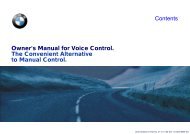Owner's Manual for the vehicle. With a quick reference ... - E38.org
Owner's Manual for the vehicle. With a quick reference ... - E38.org
Owner's Manual for the vehicle. With a quick reference ... - E38.org
Create successful ePaper yourself
Turn your PDF publications into a flip-book with our unique Google optimized e-Paper software.
122n<br />
Break-in procedure<br />
To ensure that your <strong>vehicle</strong> provides<br />
maximum economy throughout a long<br />
service life, we request that you comply<br />
with <strong>the</strong> following:<br />
Engine and differential<br />
Up to 1,200 miles (2,000 km):<br />
Drive at varying engine speeds and<br />
road speeds, but do not exceed<br />
4500 rpm and/or 105 mph (170 km/h)<br />
during this initial period. Comply with Brake system<br />
<strong>the</strong> legal speed limit at all times.<br />
Refrain from using full throttle and avoid<br />
pressing <strong>the</strong> accelerator beyond <strong>the</strong><br />
kickdown point.<br />
Once 1,200 miles (2,000 km) have<br />
elapsed, engine speeds and road<br />
speeds can gradually be increased.<br />
You should also comply with <strong>the</strong>se<br />
break-in procedures if <strong>the</strong> engine or differential<br />
is replaced later in <strong>the</strong> course<br />
of <strong>the</strong> <strong>vehicle</strong> service life.<br />
When <strong>the</strong> <strong>vehicle</strong> is operated on<br />
wet or slushy roads, a wedge of<br />
water may <strong>for</strong>m between <strong>the</strong> tire and<br />
<strong>the</strong> road surface. This phenomenon is<br />
referred to as aquaplaning, or hydroplaning,<br />
and can lead to partial or complete<br />
loss of traction, <strong>vehicle</strong> control<br />
and braking effectiveness. Reduce your<br />
speed on wet roads.<<br />
Approximately 300 miles (500 km) must<br />
elapse be<strong>for</strong>e <strong>the</strong> brake pads and rotors<br />
achieve <strong>the</strong> optimal pad-surface and<br />
wear patterns required <strong>for</strong> trouble-free<br />
operation and long service life later on.<br />
To break-in <strong>the</strong> separate parking brake<br />
drums, apply <strong>the</strong> parking brake lightly<br />
when coasting to a standstill (at a traffic<br />
signal, <strong>for</strong> instance), provided that traffic<br />
conditions allow you to do so.<br />
To avoid corrosion, repeat this procedure<br />
from time to time.<br />
The brake lamps do not come on<br />
when <strong>the</strong> parking brake is applied.<br />
Vacuum <strong>for</strong> <strong>the</strong> brake system servo unit<br />
on your BMW is available only when <strong>the</strong><br />
engine is running. When you move <strong>the</strong><br />
car with <strong>the</strong> engine shut off – when towing,<br />
<strong>for</strong> instance – substantially higher<br />
levels of pedal <strong>for</strong>ce will be required to<br />
brake <strong>the</strong> <strong>vehicle</strong>.<<br />
Tires<br />
Due to technical factors associated with<br />
<strong>the</strong>ir manufacture, tires do not achieve<br />
<strong>the</strong>ir full traction potential until an initial<br />
break-in period has elapsed.<br />
Thus drive with extra care during <strong>the</strong><br />
initial 200 miles (300 km).



